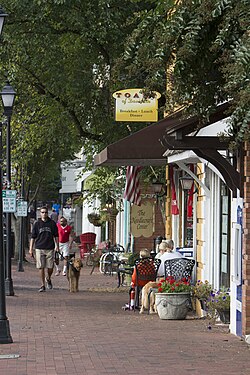Davidson, NC
| Davidson, North Carolina | |
|---|---|
| Town | |

Main Street
|
|
| Motto: "College Town. Lake Town. Your Town." | |
 Location of Davidson, North Carolina |
|
| Coordinates: 35°29′28″N 80°49′58″W / 35.49111°N 80.83278°WCoordinates: 35°29′28″N 80°49′58″W / 35.49111°N 80.83278°W | |
| Country | United States |
| State | North Carolina |
| Counties | Mecklenburg |
| Area | |
| • Total | 5.1 sq mi (13.1 km2) |
| • Land | 4.9 sq mi (12.6 km2) |
| • Water | 0.2 sq mi (0.5 km2) |
| Elevation | 840 ft (256 m) |
| Population (2010) | |
| • Total | 10,944 |
| • Density | 2,233.5/sq mi (868.6/km2) |
| Time zone | Eastern (EST) (UTC-5) |
| • Summer (DST) | EDT (UTC-4) |
| ZIP codes | 28035-28036 |
| Area code(s) | 704 980 |
| FIPS code | 37-16400 |
| GNIS feature ID | 1019914 |
| Website | http://www.ci.davidson.nc.us |
Davidson is a lakeside town on Lake Norman in northern Mecklenburg County in the U.S. state of North Carolina. The population was 10,944 at the 2010 census. It is home to Davidson College. The town is centered on the college from which it takes its name.
The town was founded in 1837 with the establishment of the Presbyterian Davidson College, named for Brigadier General William Lee Davidson, a local Revolutionary War hero in Mecklenburg County. The land for Davidson College came from Davidson's estate, a large portion of which was donated by his son.
The history of the town of Davidson is inextricably linked to Davidson College, which predated the surrounding community and influenced its development. Although Davidson’s growth in the late nineteenth and early twentieth centuries typified small railroad towns throughout the Piedmont, the presence of the college created a unique village. The tree-shaded campus filled with classically inspired architecture distinguished Davidson from other communities. The sway of the school also extended beyond the campus to the entire town, influencing commerce, culture, and the character of its architecture. The 1869 Branson’s business directory recorded four dry goods merchants in the town as well as a cabinetmaker, a miller, and three physicians.
Soon after the arrival of the railroad, Davidson became a shipping point for cash crops, especially cotton, and a service center for farmers. In common with other railroad towns in the region, textile investors constructed cotton mills and mill villages along the rail corridor. The Linden Cotton Factory, erected in 1890 on Depot Street, was the first textile plant in Davidson, and in 1908, the Delburg Cotton Mills was constructed nearby. Two thousand bales of cotton were sold at Davidson annually in the early 1900s.
In 1891, the name of the town was changed from Davidson College to Davidson, emblematic of the community’s expanding roles for town and gown alike. Davidson’s cotton mills spurred the growth of the town, and by 1910, the population of Davidson reached 500 residents, climbing to 1,500 by the 1920s. Between 1900 and the Great Depression, the business district evolved from a commingling of stores and residences into contiguous rows of one- and two-story, brick commercial buildings. The heart of downtown – opposite the college – contained a full complement of small town stores and services, including four general merchandise stores, a drug store, a laundry, tailor shop, two barber shops, a hardware store, a post office, a bank, and several restaurants. Physicians, building contractors, and milliners also had Main Street addresses. Behind Main Street along the railroad tracks stood the small 1897 Southern Railway Depot, a livery, flour mill, sawmill, cotton gins, a cottonseed oil company, a blacksmith shop, and a buggy manufacturer.
...
Wikipedia
